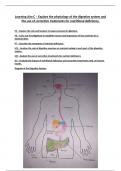Learning Aim C – Explore the physiology of the digestive system and
the use of corrective treatments for nutritional deficiency.
P5 – Explore the role and location of organs involved in digestion.
P6 – Carry out investigations to establish sources and importance of key nutrients for a
balanced diet.
P7 – Describe the symptoms of nutrient deficiency.
M3 – Analyse the role of digestive enzymes on nutrient uptake in each part of the digestive
system.
M4 – Explain the use of corrective treatments for nutrient deficiency
D3 – Evaluate the impact of nutritional deficiency and corrective treatments used, on human
health.
Diagram of the Digestive System:
,The digestive system is a complex series of organs that churn food and liquids that breaks down
the food for energy, growth and tissue repair, as well as absorbing nutrients. This will help allow
the body to grow and remain healthy.
Function of organs:
Mouth – the mouth is the beginning of the digestive system, and is the location where digestion
takes place before consuming the first bite of a meal. The mouth is adapted to receive food
through ingestion, by breaking is into small particles. The lips, cheeks and palate form
boundaries when the mouth is breaking food.
Teeth – the teeth break down food into smaller pieces and play a huge part in swallowing and
further digestion. The incisors, which are in the front of the lower and upper jaws are used to cut
pieces of food and he molars, which are in the back of the mouth are responsible for grinding
and chewing.
Tongue – one of the main functions of the tongue during digestion is to mix the food items with
saliva and help the teeth masticate it. In addition to this, the tongue is used to assist with the
swallowing of food. The tongue also works alongside the teeth to help grind the food items.
Epiglottis – the epiglottis is upright at rest, allowing air to pass into the larynx and lungs. The
larynx is a 5cm tube that blocks food from entering an individuals’ windpipe when swallowing.
When an individual swallows, the epiglottis folds backwards in order to cover the entrance of
the larynx in order to ensure the food does not enter the windpipe. After the process of
swallowing has taken place; the epiglottis will return to its original position in order to allow air
into the larynx.
Salivary glands – the salivary glands play an important part in digestion, as they produce saliva.
Saliva takes part in digestion by moistening the food so that individuals can swallow without
difficulty. In addition to this, our saliva contains an enzyme known as ‘amylase’ which helps the
stomach break down any starches. There are three types of salivary gland: the parotid gland,
which produces a watery secretion; the submaxillary glands which produce a mixed secretion
combined of serous and mucous, as well as the sublingual glands, which secrete a type of saliva
that is predominantly made up of mucous.
Pharynx – the pharynx, which is also known as the throat is known for allowing the passage of
swallowed solids and liquids into the oesophagus. The pharynx is also involved in the respiratory
, system, conducting air to and from the trachea and carrying air, food and fluid down the nose
and throat.
Oesophagus – the oesophagus is a muscular tube that connects the mouth to the stomach. The
main function of the oesophagus during digestion is to transfer food and liquid from the mouth
to the stomach. When food is swallowed, the walls of the oesophagus contract, which moves
the food down the oesophagus to the stomach. The upper part of the oesophagus connects the
mouth to the lungs, so that it is easier to breathe. The bottom part of the oesophagus is below
the diaphragm, which is where the oesophagus joins to the stomach.
Liver – there are two important roles that the liver plays during digestion. Firstly, the liver makes
and secretes bile. Bile is a chemical that turns fats into energy for our body to use. In addition to
this, the liver processes and purifies our blood which contains newly absorbed nutrients, which
are released from the small intestine.
Stomach – the stomach is an organ that plays a key part during digestion. It produces enzymes,
which create chemical reactions and digestive acids. This combination helps breaks down food
so that it can be passed to our small intestine.
Gall Bladder - the gallbladder is a pear-shaped organ that stores bile from the liver. Bile is a
mixture of cholesterol, bilirubin and bile salts. The bile is then released into the duodenum,
which is the first section of the small intestine. This is where the gallbladder helps an individual
break down and absorb fats that have been collected from food. Before an individual starts
eating, the gallbladder is full of bile. When the first few bites are consumed, the gallbladder
receives signals to contract and squeeze the bile out of the biliary tract, before passing into the
duodenum where it gradually mixes with the food, collecting fats and absorbing them. Once an
individual has finished eating, the gallbladder will become empty again and be in similar shape
to a deflated balloon, waiting to be filled up again whenever an individual consumes their next
meal.
Pancreas – during digestion, the pancreas produces pancreatic juices which are known as
enzymes. These enzymes are used to break down sugars, fats and starches. In addition to this,
our pancreas helps the digestive system by producing hormones, which are chemical
messengers that travel through our blood. One of the hormones that the pancreas produces is
known as ‘insulin.’ This is secreted into the bloodstream and regulates the body’s glucose and
sugar levels.




